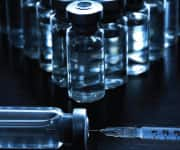Life Extension Magazine®
Increasing Prevalence of Obesity and Diabetes

From 1960 to 1980 about 15% of American adults were obese (BMI 30 or greater), but by the year 2002 that figure had doubled to over 30%.1 The prevalence of American children and adolescents classified as overweight roughly tripled between 1980 and 2000.1 But the problem is not restricted to the United States, as obesity and overweight diagnoses are increasing worldwide. Prevalence of childhood obesity in Brazil and India were recently estimated to be 22%, and for Mexico nearly 42%.2 Along with the increase in global obesity there has been a rise in type II diabetes 3 (formerly called adult-onset diabetes before it affected so many children).
How Type II Diabetes Develops
Diabetes is generally defined as a condition of elevated glucose. Insulin, which is secreted from islet cells in the pancreas, helps glucose enter many body tissues. In type I diabetes, a person typically has little or no insulin production. More than 90% of all diabetics have type II rather than type I diabetes, however.4 Obesity often leads to insulin resistance, wherein it becomes more difficult for insulin to cause glucose uptake by cells. As a result of increasing insulin resistance, the pancreas increases insulin production and release in an attempt to get enough glucose into cells. Eventually pancreatic insulin production ceases, and type II diabetes progresses to an advanced stage.5,6
Although insulin resistance is the best predictor for the development of type II diabetes, experts have different opinions concerning the mechanisms causing insulin resistance.
Keystone Symposia
Keystone Symposia is a nonprofit organization that holds many scientifically prestigious conferences on a variety of topics in molecular and cellular biology. From January 27 to February 1, 2013, a symposium was held in Keystone, Colorado, on the subjects of diabetes and adipose tissue biology, organized and attended by leading scientific researchers in the field.
Insulin Resistance from Fat

Possibly no one has studied insulin resistance harder and longer than Gerald Shulman, MD, PhD (Professor of Medicine, Yale University, New Haven, Connecticut). Shulman’s favorite hypothesis is that excessive fat from the diet (or fat generated by high levels of fructose consumption) accumulates in cells, interfering with the cell-signaling involved in the pathway between a cell’s insulin receptor and uptake of glucose by the cell.7-9 In particular, the protein that transports glucose into a cell (GLUT4 protein) is prevented by fat from reaching the cell surface.10 When I asked Dr. Shulman about the effect of fat saturation (saturated fat) and chain-length of fatty acids on insulin resistance, he told me that these properties of fat do not matter (excluding fish oil, which he said has special signaling capabilities).

Kitt Petersen, MD (Professor of Medicine, Yale University, New Haven, Connecticut) has long been Dr. Shulman’s understudy and has co-authored many papers with him. Dr. Petersen has been focused on the role of exercise and mitochondria in insulin resistance. She has shown that exercise and weight loss increase insulin sensitivity.11,12 She has found evidence that age-associated decline of mitochondrial function is associated with defective fat metabolism, leading to fat accumulation and insulin resistance.13,14 Like Shulman, she believes that inflammation is a consequence rather than a cause of insulin resistance.15 When I asked her about the molecular mechanism behind insulin resistance in smokers, she told me that there are probably many mechanisms of insulin resistance and there is much to be learned about the subject.16,17
Insulin Resistance from Inflammation

Alan Saltiel, PhD (Director, Life Sciences Institute, University of Michigan, Ann Arbor, Michigan) favors the view that inflammation is the link between obesity and insulin resistance. He has shown that mice that are genetically modified to not release the pro-inflammatory molecule NF-κB when fed a high-fat diet are protected from insulin resistance.18 He later showed that normal mice are similarly protected from insulin resistance due to a high-fat diet when given a chemical inhibitor that blocks NF-κB activation.19

Tal Pecht (PhD student, Ben-Gurion University, Beer-Sheva, Israel) believes that inflammation from body fat (especially visceral fat) leads to insulin resistance. She cited studies indicating that necrotic cell death of fat cells attracts macrophages which may lead to insulin resistance. 20-22 With her supervisor, Pecht demonstrated that macrophages in visceral fat form foam cells such as those found in atherosclerotic plaques, which results in inflammation and possibly insulin resistance.23
Nutrients that health conscious people take today like curcumin, cinnamon, silymarin, and genistein (an isoflavone found in soybeans) suppress the pro-inflammatory molecule NF-κB.24-28
Distribution of Body Fat
Susan Fried, PhD (Professor, Boston University School of Medicine, Boston, Massachusetts) has studied the relationship between body fat distribution and diabetes or cardiovascular disease. With increasing obesity, men become “apples” (round, more abdominal fat), whereas women become “pears” (more fat in the hips and thighs). Only abdominal fat is associated with increased cardiovascular disease and diabetes.29,30 After menopause, however, women accumulate more abdominal fat.31
The Effect of When You Eat

Paolo Sassone-Corsi, PhD (Director, Center for Epigenetics and Metabolism, University of California, Irvine) presented evidence that disruption of biological clocks associated with the sleep-wake cycle and feeding can lead to cardiovascular disease and insulin resistance.32,33 Similar effects are seen for mice as for human shift-workers. Mice subjected to light at night have more body mass and less glucose tolerance than mice under normal light/dark conditions, despite equivalent food intake and activity.34 He said that when you eat can be as important as what you eat.
Genetic Causes of Obesity and Type II Diabetes

Ronald Kahn, MD (Professor of Medicine, Harvard Medical School, Boston, Massachusetts) has been studying genetic factors that influence obesity and type II diabetes in humans and mice. High metabolic rate and high levels of energy-generating brown fat are genetic influences that protect against obesity. 35,36 Kahn has demonstrated in mice that genetic background also governs the degree to which obesity will lead to inflammation or insulin resistance.37 Dr. Kahn is currently following leads that the type of bacteria in the intestine influences the development of insulin resistance and type II diabetes.38
FGF21 and Longevity

David Mangelsdorf, PhD (Professor and Chairman of the Department of Pharmacology, University of Texas Southwestern Medical Center, Dallas, Texas) has been studying Fibroblast Growth Factor 21 (FGF21), a growth factor secreted in the liver during fasting that has been shown to increase liver insulin sensitivity in rats made obese by a high-fat diet.39 Dr. Mangelsdorf has created mice that secrete more-than-normal amounts of FGF21 and live 30-40% longer without any calorie restriction.40 Like Snell and Ames dwarf mice (which also live longer than normal mice) the FGF21 transgenic mice are small, are more growth-hormone resistant, and are more insulin sensitive than normal mice.40,41
Inflammation from Aging Rather Than from Fat

James Kirkland, MD, PhD (Professor of Medicine, Mayo Clinic, Rochester, Minnesota) has observed that although insulin resistance, type II diabetes, and inflammation continually increase with age, obesity begins to decline in late middle age. Although the inflammation associated with obesity mainly comes from macrophages, the inflammation associated with aging mainly comes from fat cells.42 Obesity is associated with fat deposition in tissues other than fat cells, which is believed to cause insulin resistance and fat toxicity.43 Saturated fats have been shown to kill heart cells. 44 Fat toxicity impedes the function of and can even kill the insulin-producing cells of the pancreas.45,46 Dr. Kirkland has shown that aging increases susceptibility to fat toxicity.47 Certain saturated fats have been shown to kill cells by increasing synthesis of the waxy fats or by other means.48-50 Certain waxy fats can cause insulin resistance.51
Dr. Kirkland believes that much of the chronic inflammation associated with aging and type II diabetes is due to inflammatory proteins (cytokines) secreted from senescent (old or damaged) fat cells, noting that fat is the largest organ in the body for an increasing percentage of the population.52,53 Dr. Kirkland initiated a study which showed that partial rejuvenation results from eliminating senescent cells in a mouse with accelerated aging. 54 He is currently seeking to replicate that study in normal mice.
Binge Drinking and Type II Diabetes

Christoph Buettner, MD, PhD (Director, Laboratory for Metabolism and Diabetes, Mount Sinai School of Medicine, New York City, New York) was inspired by human epidemiological evidence that binge drinking leads to chronic insulin resistance or diabetes55-57 to investigate the molecular mechanisms in rats. He found that ethanol dosing in rats that simulates human binge drinking is toxic to the hypothalamus, and thereby induces insulin resistance. 58 Short-term insulin resistance lasts for days after all the ethanol has been metabolized.58 Dr. Buettner is concerned that binge drinking continues to increase among college students.59 Adolescents are particularly vulnerable to brain damage from binge drinking. 60
Summary
I had made it a priority to attempt to gain from this conference an understanding of the mechanism by which insulin resistance is induced. I was surprised that opinions on this subject could be so different, but I believe that some of the reason for the divergence of views is that there is more than one mechanism involved. In particular, I think that in some cases inflammation can induce insulin resistance, whereas in other cases fat directly impedes cell signaling between the insulin receptor and the glucose transporter.
If you have any questions on the scientific content of this article, please call a Life Extension® Health Advisor at 1-866-864-3027.
References
- Flegal KM. Epidemiologic aspects of overweight and obesity in the United States. Physiol Behav. 2005 Dec 15;86(5):599-602.
- Gupta N, Goel K, Shah P, Misra A. Childhood obesity in developing countries: epidemiology, determinants, and prevention. Endocr Rev. 2012 Feb;33(1):48-70.
- Chen L, Magliano DJ, Zimmet PZ. The worldwide epidemiology of type 2 diabetes mellitus--present and future perspectives. Nat Rev Endocrinol. 2011 Nov 8;8(4):228-36.
- McNamara DB, Murthy SN, Fonseca AN, Desouza CV, Kadowitz PJ, Fonseca VA. Animal models of catheter-induced intimal hyperplasia in type 1 and type 2 diabetes and the effects of pharmacologic intervention. Can J Physiol Pharmacol. 2009 Jan;87(1):37-50.
- Cnop M, Welsh N, Jonas JC, Jörns A, Lenzen S, Eizirik DL. Mechanisms of pancreatic beta-cell death in type 1 and type 2 diabetes: many differences, few similarities. Diabetes. 2005 Dec;54 Suppl 2:S97-107.
- Quan W, Lim YM, Lee MS. Role of autophagy in diabetes and endoplasmic reticulum stress of pancreatic β-cells. Exp Mol Med. 2012 Feb 29;44(2):81-8.
- Stanhope KL. Role of fructose-containing sugars in the epidemics of obesity and metabolic syndrome. Annu Rev Med. 2012;63:329-43.
- Tappy L, Lê KA, Tran C, Paquot N. Fructose and metabolic diseases: new findings, new questions. Nutrition. 2010 Nov-Dec;26(11-12):1044-9.
- Samuel VT, Shulman GI. Mechanisms for insulin resistance: common threads and missing links. Cell. 2012 Mar 2;148(5):852-71.
- Shulman GI. Cellular mechanisms of insulin resistance. J Clin Invest. 2000 Jul;106(2):171-6.
- Rabøl R, Petersen KF, Dufour S, Flannery C, Shulman GI. Reversal of muscle insulin resistance with exercise reduces postprandial hepatic de novo lipogenesis in insulin resistant individuals. Proc Natl Acad Sci U S A. 2011 Aug 16;108(33):13705-9.
- Petersen KF, Dufour S, Morino K, Yoo PS, Cline GW, Shulman GI. Reversal of muscle insulin resistance by weight reduction in young, lean, insulin-resistant offspring of parents with type 2 diabetes. Proc Natl Acad Sci U S A. 2012 May 22;109(21):8236-40.
- Petersen KF, Befroy D, Dufour S, et al. Mitochondrial dysfunction in the elderly: possible role in insulin resistance. Science. 2003 May 16;300(5622):1140-2.
- Befroy DE, Petersen KF, Dufour S, et al. Impaired mitochondrial substrate oxidation in muscle of insulin-resistant offspring of type 2 diabetic patients. Diabetes. 2007 May;56(5):1376-81.
- Petersen KF, Dufour S, Savage DB, et al. The role of skeletal muscle insulin resistance in the pathogenesis of the metabolic syndrome. Proc Natl Acad Sci U S A. 2007 Jul 31;104(31):12587-94.
- Tonstad S. Cigarette smoking, smoking cessation, and diabetes. Diabetes Res Clin Pract. 2009 Jul;85(1):4-13.
- Chiolero A, Faeh D, Paccaud F, Cornuz J. Consequences of smoking for body weight, body fat distribution, and insulin resistance. Am J Clin Nutr. 2008 Apr;87(4):801-9.
- Chiang SH, Bazuine M, Lumeng CN, et al. The protein kinase IKKepsilon regulates energy balance in obese mice. Cell. 2009 Sep 4;138(5):961-75.
- Reilly SM, Chiang SH, Decker SJ, et al. An inhibitor of the protein kinases TBK1 and IKK-ɛ improves obesity-related metabolic dysfunctions in mice. Nat Med. 2013 Mar;19(3):313-21.
- Cinti S, Mitchell G, Barbatelli G, et al. Adipocyte death defines macrophage localization and function in adipose tissue of obese mice and humans. J Lipid Res. 2005 Nov;46(11):2347-55.
- Weisberg SP, McCann D, Desai M, Rosenbaum M, Leibel RL, Ferrante AW Jr. Obesity is associated with macrophage accumulation in adipose tissue . J Clin Invest. 2003 Dec;112(12):1796-808.
- Xu H, Barnes GT, Yang Q, et al. Chronic inflammation in fat plays a crucial role in the development of obesity-related insulin resistance. J Clin Invest. 2003 Dec;112(12):1821-30.
- Shapiro H, Pecht T, Shaco-Levy R, et al. Adipose tissue foam cells are present in human obesity. J Clin Endocrinol Metab. 2013 Mar;98(3):1173-81.
- Bradford PG. Curcumin and obesity. Biofactors. 2013 Jan;39(1):78-87.
- Ho SC, Chang KS, Chang PW. Inhibition of neuroinflammation by cinnamon and its main components. Food Chem. 2013 Jun 15;138(4):2275-82.
- Gharagozloo M, Velardi E, Bruscoli S, et al. Silymarin suppress CD4+ T cell activation and proliferation: effects on NF-kappaB activity and IL-2 production. Pharmacol Res. 2010 May;61(5):405-9.
- Yamasaki M, Mine Y, Nishimura M, et al. Genistein induces apoptotic cell death associated with inhibition of the NF-κB pathway in adult T-cell leukemia cells. Cell Biol Int. 2013 Mar 22.
- Ralhan R, Pandey MK, Aggarwal BB. Nuclear factor-kappa B links carcinogenic and chemopreventive agents. Front Biosci (Schol Ed). 2009 Jun 1;1:45-60.
- Wahrenberg H, Lönnqvist F, Arner P. Mechanisms underlying regional differences in lipolysis in human adipose tissue. J Clin Invest. 1989 Aug;84(2):458-67.
- Van Pelt RE, Jankowski CM, Gozansky WS, Schwartz RS, Kohrt WM. Lower-body adiposity and metabolic protection in postmenopausal women . J Clin Endocrinol Metab. 2005 Aug;90(8):4573-8.
- Garaulet M, Pérez-Llamas F, Baraza JC, Garcia-Prieto MD, Fardy PS, Tébar FJ, Zamora S. Body fat distribution in pre-and post-menopausal women: metabolic and anthropometric variables. J Nutr Health Aging. 2002;6(2):123-6.
- Eckel-Mahan K, Sassone-Corsi P. Metabolism and the circadian clock converge. Physiol Rev. 2013 Jan;93(1):107-35.
- Marcheva B, Ramsey KM, Buhr ED, et al. Disruption of the clock components CLOCK and BMAL1 leads to hypoinsulinaemia and diabetes. Nature. 2010 Jul 29;466(7306):627-31.
- Fonken LK, Workman JL, Walton JC, et al. Light at night increases body mass by shifting the time of food intake. Proc Natl Acad Sci U S A. 2010 Oct 26;107(43):18664-9.
- Almind K, Kahn CR. Genetic determinants of energy expenditure and insulin resistance in diet-induced obesity in mice. Diabetes. 2004 Dec;53(12):3274-85.
- Almind K, Manieri M, Sivitz WI, Cinti S, Kahn CR. Ectopic brown adipose tissue in muscle provides a mechanism for differences in risk of metabolic syndrome in mice. Proc Natl Acad Sci U S A. 2007 Feb 13;104(7):2366-71.
- Mori MA, Liu M, Bezy O, et al. A systems biology approach identifies inflammatory abnormalities between mouse strains prior to development of metabolic disease. Diabetes. 2010 Nov;59(11):2960-71.
- Burcelin R, Serino M, Chabo C, Blasco-Baque V, Amar J. Gut microbiota and diabetes: from pathogenesis to therapeutic perspective. Acta Diabetol. 2011 Dec;48(4):257-73.
- Sarruf DA, Thaler JP, Morton GJ, et al. Fibroblast growth factor 21 action in the brain increases energy expenditure and insulin sensitivity in obese rats. Diabetes. 2010 Jul;59(7):1817-24.
- Zhang Y, Xie Y, Berglund ED, et al. The starvation hormone, fibroblast growth factor-21, extends lifespan in mice. Elife. 2012;1:e00065.
- Bartke A, Brown-Borg H. Life extension in the dwarf mouse. Curr Top Dev Biol. 2004;63:189-225.
- Wu D, Ren Z, Pae M, et al. Aging up-regulates expression of inflammatory mediators in mouse adipose tissue. J Immunol. 2007 Oct 1;179(7):4829-39.
- Wende AR, Abel ED. Lipotoxicity in the heart. Biochim Biophys Acta. 2010 Mar;1801(3):311-9.
- de Vries JE, Vork MM, Roemen TH, et al. Saturated but not mono-unsaturated fatty acids induce apoptotic cell death in neonatal rat ventricular myocytes. J Lipid Res. 1997 Jul;38(7):1384-94.
- Leitão CB, Bernetti K, Tharavanij T, et al. Lipotoxicity and decreased islet graft survival. Diabetes Care. 2010 Mar;33(3):658-60.
- Solinas G, Naugler W, Galimi F, Lee MS, Karin M. Saturated fatty acids inhibit induction of insulin gene transcription by JNK-mediated phosphorylation of insulin-receptor substrates. Proc Natl Acad Sci U S A. 2006 Oct 31;103(44):16454-9.
- Guo W, Pirtskhalava T, Tchkonia T, et al. Aging results in paradoxical susceptibility of fat cell progenitors to lipotoxicity. Am J Physiol Endocrinol Metab. 2007 Apr;292(4):E1041-51.
- Assimacopoulos-Jeannet F. Fat storage in pancreas and in insulin-sensitive tissues in pathogenesis of type 2 diabetes. Int J Obes Relat Metab Disord. 2004 Dec;28 Suppl 4:S53-7.
- Alkhouri N, Dixon LJ, Feldstein AE. Lipotoxicity in nonalcoholic fatty liver disease: not all lipids are created equal. Expert Rev Gastroenterol Hepatol. 2009 Aug;3(4):445-51.
- Listenberger LL, Ory DS, Schaffer JE. Palmitate-induced apoptosis can occur through a ceramide-independent pathway. J Biol Chem. 2001 May 4;276(18):14890-5.
- Chavez JA, Knotts TA, Wang LP, Li G, Dobrowsky RT, Florant GL, Summers SA. A role for ceramide, but not diacylglycerol, in the antagonism of insulin signal transduction by saturated fatty acids. J Biol Chem. 2003 Mar 21;278(12):10297-303.
- Tchkonia T, Morbeck DE, Von Zglinicki T, et al. Fat tissue, aging, and cellular senescence. Aging Cell. 2010 Oct;9(5):667-84.
- Lumeng CN, Liu J, Geletka L, et al. Aging is associated with an increase in T cells and inflammatory macrophages in visceral adipose tissue. J Immunol. 2011 Dec 15;187(12):6208-16.
- Baker DJ, Wijshake T, Tchkonia T, et al. Clearance of p16Ink4a-positive senescent cells delays ageing-associated disorders. Nature. 2011 Nov 2;479(7372):232-6.
- Carlsson S, Hammar N, Grill V, Kaprio J. Alcohol consumption and the incidence of type 2 diabetes: a 20-year follow-up of the Finnish twin cohort study. Diabetes Care. 2003 Oct;26(10):2785-90.
- Cullmann M, Hilding A, Östenson CG. Alcohol consumption and risk of pre-diabetes and type 2 diabetes development in a Swedish population. Diabet Med. 2012 Apr;29(4):441-52.
- Fan AZ, Russell M, Naimi T, et al. Patterns of alcohol consumption and the metabolic syndrome. J Clin Endocrinol Metab. 2008 Oct;93(10):3833-8.
- Lindtner C, Scherer T, Zielinski E, et al. Binge drinking induces whole-body insulin resistance by impairing hypothalamic insulin action. Sci Transl Med. 2013 Jan 30;5(170):170ra14.
- Mitka M. College binge drinking still on the rise. JAMA. 2009 Aug 26;302(8):836-7.
- Crews FT, Mdzinarishvili A, Kim D, He J, Nixon K. Neurogenesis in adolescent brain is potently inhibited by ethanol. Neuroscience. 2006;137(2):437-45.

